Horseshoes were initially introduced to protect feet of working horses, in order to make the animals more useful to their riders, and nailed horseshoes were first identified in Roman times.
However, barefoot followers claim that there are various benefits to removing what is essentially a product of domestication.
If you are new to barefoot, you may have some burning questions - so here is our FAQ list! (Of course, discussing your options with a good hoof care practitioner is always the best way to help you to decide if taking your horse barefoot is the best option.)

1.What’s so bad about shoes?
Opinions vary, but my own education and research into barefoot hoofcare has shown me that horse shoes are detrimental to natural hoof function and circulation, and can also cause pathologies in the hoof, as well as limb or joint strains caused by the limitation of natural movement.
2.Why is barefoot better for circulation?
Studies show that in a shod hoof on a flat surface, blood flow actually comes to a halt for a split second with every heartbeat at the level of the horse’s fetlock. Lack of circulation can also play a part in bone degeneration, leading to degenerative diseases. Due to the limiting effects of a nailed on shoe, it is widely recognised that the horse’s heart will have to work harder to push the blood down through the hoof and back up the leg in a shod horse.
3.How long will transitioning from shod to bare take?
Many factors affect the transitioning process, which could take the duration of the hoof’s new growth (around a year), or just a few trim cycles, depending on the circumstances, and the horse’s proposed workload and type. If you feed a low starch, low sugar diet that is optimised with the right mineral balance, give the horse a controlled, varied exercise regime over different surfaces, and work with a knowledgeable hoofcare practitioner, your transitioning will be as fast as nature allows.
4.Can hoof boots help?
Hoof boots help boost the hoof’s shock absorption properties, and also protect the hoof on sharp, uneven or stony surfaces. the need for hoof boots very much depends on the horse – for example, its breed, its build, the length of time it has been without shoes, the condition of its feet, its diet, its exercise regime, the action of the limbs, and a combination of these factors. many barefooted horses will benefit from wearing hoof boots, especially through the transitionary phase after de-shoeing, and sometimes beyond, for example if extra shock absorption is required over challenging surfaces.
They were first used in Europe in the 19th Century, when European farm workers and draught horse owners tasked saddlers to create leather hoof boots to provide traction for working horses. The boots gave increase grip over all types of terrain, and on uneven and slippery surfaces such as cobbled streets.
An example of a popular modern hoof boot is Easycare’s Easyboot Transition - its sole uses three layers of material to produce a resilient shock absorbing layer that gives support and stimulation to the hoof structures. Like most hoof boots, the Transition is sold in singles, although hoof boots are always worn in pairs, commonly on the forefeet.
5.Does anyone well-known go ‘barefoot’?
American dressage star Shannon Peters, who competes barefoot at the highest levels, says: “As more people learn that there are ways to make their horses more sound, increase the longevity of their equine partners, and have happier and healthier partners, I can’t see why barefoot trimming won’t continue to grow in competitive dressage. [With barefoot], the natural blood pumping mechanism of the foot starts to work properly again, legs tighten up, and the horses are generally more sound.”
British rider Keith Robertson of Herfordshire-based Wild Farm Dressage competes a range of horses from Novice to Prix St George level, and utilises barefoot where possible. Keith says "If a horse has good feet and doesn't need the influence or interference of shoes, then why have them?”
Newmarket-based racehorse trainer Simon Earle trains national hunt and flat horses, and 90% of the equines he trains are barefoot. He says the team’s main aim is to maintain horses that are fit, healthy, happy, well educated and sound. “Be it barefoot or with correct shoeing, soundness is of the utmost importance to enable me to train a horse successfully,” he says.
Italian showjumper Luca Maria Moneta famously won the Olympia 2013 Alltech Puissance in London with his barefoot mare, Quova du Vains; many of his horses are unshod. “My horses are allowed to be horses; they are often unshod,” he states.
Further information and useful links-
Barefoot Horse - an independent information resource with a list of UK based barefoot trimmers and training providers
Barefoot South - regional trimmer with extensive articles and blogs
Equine Podiatry Association
Performance Barefoot- site of sarah braithwaite, co-founder of uknhcp
Rockley Farm Equine Rehabilitation and Natural Hoofcare
UK Natural Hoof Care Practitioners












